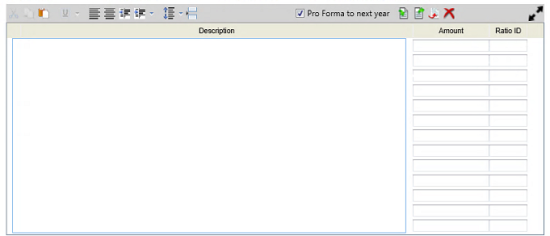For tax years 2015 and higher, the Footnote editor includes features similar to other text editors, such as Notepad. The Footnote editor includes three components; the button bar, the Footnote pane that is used to enter text, and the Amount column that is used to enter numeric values.
For tax years 2016 and higher, Partnership and S Corporation K-1 packages include an additional Ratio ID column to the right of the Amount column. Each line of the footnote can be separately allocated by entering a ratio ID number to specify certain partners or shareholders to receive that line and to specially allocate an amount reported in the footnote.
Footnote information is entered in the General > Notes worksheet for federal, state, and city returns and is included in the Statements page of the printed return. For Partnership, S Corporation, and Fiduciary K-1 packages, the Footnote editor is located in the Partners (1065), Shareholders (1120S), or Beneficiaries (1041) > Schedule K-1 Footnotes worksheet.

Entering Text and Amounts
You can create a footnote by doing any of the following:
- Manually typing information.
- Pasting information that is copied from a source file.
- Importing information from a source file using the Import button on the Footnote editor button bar.
- Importing K-1 footnotes using the Import > K-1 Data > K-1 Data from Spreadsheet button on the Import/Export ribbon. See Importing K-1 Data from a Spreadsheet for more information. Tax provides spreadsheet templates on which you can enter data for import. You also can generate a data entry template by exporting K-1 data to a spreadsheet from a return that is of the appropriate tax year and tax system.
Important: Enter amounts beside the line of text they relate to.
Notes:
- Text that exceeds 60 characters will wrap to the next line for all returns types except Employee Benefit Plan. The maximum number of characters per line for Employee Benefit Plan returns is 53.
- There is no limit to the length of a footnote.
- You cannot paste data in the Footnote pane and Amounts grid simultaneously. Text and amounts must be pasted separately.
- Imported data displays in blue font with the exception of underlined data, which displays in black font. Data that is changed manually after import displays in black font.
Entering Ratio ID Numbers for Partnership and S Corporation K-1 Footnotes
The ratio ID number must match a ratio ID number on the Special Allocations > Ratio Allocation worksheet section. The ratio ID number referenced should generally use units for the allocation.
To allocate all lines of the footnote using the same ration ID number, enter the number in the Ratio ID number box above the editor.
Inserting Footnote Annotations
You can insert up to three tick marks and one note for each occurrence of the Footnote pane and up to three tick marks, one note, and one list in any line of the Amount grid. You can also flag numeric values in the Amount grid as estimates. Annotations in the Footnote pane display on the first line and can be rolled forward.
For Partnership and S Corporation K-1 footnotes, each ratio ID can have estimate, field note, and tick mark annotations.
Using Button Bar Features
The availability of some button bar features depends on whether you are entering text or amounts.
| Feature | Icon | Description | Available for | ||
|---|---|---|---|---|---|
| Text | Amounts | Ratio ID | |||
| Cut |

|
Removes and copies the selected text or amount so it can be pasted in another location. |

|

|

|
| Copy |

|
Copies the selected text or amount so it can be pasted in another location. |

|

|

|
| Paste |

|
Adds text or an amount that was copied from another location. Note: Any special formatting in the source location will not be added. |

|

|

|
| Underline |

|
Underlines the selected amount. You can add a single or a double underline to indicate subtotals and grand total. |

|
||
| Align left |

|
Aligns selected text to the left. |

|
||
| Center |

|
Centers the selected text. |

|
||
| Increase indent |

|
Increases the indentation level of a paragraph. |

|
||
| Decrease indent |

|
Decreases the indentation level of a paragraph. |

|
||
| Line spacing |

|
Increases the spacing between lines or paragraphs. Tip: To break wrapped text, press Enter at the desired break point. Line spacing moves the entire line of text. |

|
||
| Page break |

|
Starts the next page at the selected location to create a shorter footnote page. A dotted line is inserted to represent the page break. Note: To delete a page break, select the dotted line and press Delete. |

|

|

|
| Pro Forma to next year |

|
Rolls forward footnote text to the next tax year. Footnote amounts are not rolled forward. |

|

|
|
| Import |

|
Imports text or amounts from an Excel spreadsheet. See Importing and Exporting Data for more information. Notes:
|

|

|

|
| Export |

|
Exports text or amounts to an Excel spreadsheet. See Importing and Exporting Data for more information. |

|

|

|
| Insert |

|
Inserts a blank line above the selected line. |

|

|

|
| Delete |

|
Deletes the selected text or amount. |

|

|

|
| Expand |

|
Expands the Footnote editor to a full page of 53 lines. |

|

|

|
| Collapse |

|
Collapses the Footnote editor to the default height of 10 lines. |

|

|

|
